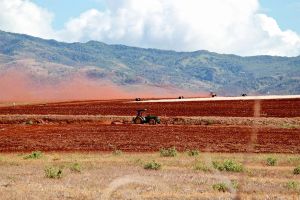Syngenta: Difference between revisions
Florez4747 (talk | contribs) No edit summary |
Florez4747 (talk | contribs) |
||
| Line 1: | Line 1: | ||
= Ka Pae Aina = | = Ka Pae Aina = | ||
[[File:RedDust.jpg||thumb|right|Red Dust coming up from biochemical fields. Photo by Samuel Morgan Shaw.]] | |||
According to [[Syngenta]]'s website they "... invest and innovate to transform the way crops are grown and protected to bring about positive, lasting change in agriculture. We help farmers manage a complex set of challenges from nature and society. Our approach is to ensure that everybody wins: that farmers are prosperous, agriculture becomes more sustainable, and consumers have safe, healthy and nutritious food."<Ref>https://www.syngenta.com/en/company/our-purpose-and-contribution</Ref> <br> | According to [[Syngenta]]'s website they "... invest and innovate to transform the way crops are grown and protected to bring about positive, lasting change in agriculture. We help farmers manage a complex set of challenges from nature and society. Our approach is to ensure that everybody wins: that farmers are prosperous, agriculture becomes more sustainable, and consumers have safe, healthy and nutritious food."<Ref>https://www.syngenta.com/en/company/our-purpose-and-contribution</Ref> <br> | ||
Revision as of 00:55, 7 February 2023
Ka Pae Aina
According to Syngenta's website they "... invest and innovate to transform the way crops are grown and protected to bring about positive, lasting change in agriculture. We help farmers manage a complex set of challenges from nature and society. Our approach is to ensure that everybody wins: that farmers are prosperous, agriculture becomes more sustainable, and consumers have safe, healthy and nutritious food."[1]
Syngenta's method of achieving these, seemingly, noble goals is by wantonly spraying toxic pesticides and insecticides over crops to test their resistance to the chemicals and as a result the Ka Pae Aina's Native residents have been poisoned enmasse by these loosely regulated experiments. Residents have described the test sites as releasing large red dust clouds into the air covering their houses and cars with a thin layer of red- especially during periods of high winds. Because the island is able to grow food year round these types of experiments, involving mass chemical spraying of crops, also occur year round.[2][3]
